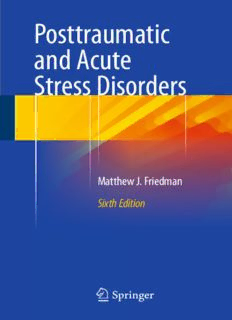
Posttraumatic and Acute Stress Disorders PDF
Preview Posttraumatic and Acute Stress Disorders
Posttraumatic and Acute Stress Disorders Matthew J. Friedman Sixth Edition 123 Posttraumatic and Acute Stress Disorders Matthew J . Friedman Posttraumatic and Acute Stress Disorders Sixth Edition Matthew J . Friedman National Center for PTSD U.S. Department of Veterans Affairs White River Junction , VT , USA Departments of Psychiatry and Pharmacology & Toxicology Geisel School of Medicine at Dartmouth Hanover , NH , USA ISBN 978-3-319-15065-9 ISBN 978-3-319-15066-6 (eBook) DOI 10.1007/978-3-319-15066-6 Library of Congress Control Number: 2015930205 Springer Cham Heidelberg New York Dordrecht London 1st edition: © Compact Clinicals 2000 2nd edition: © Compact Clinicals 2001 3rd edition: © Compact Clinicals 2003 4th edition: © Compact Clinicals 2006 5th edition: © Jones & Bartlett 2012 © Springer International Publishing Switzerland 2015 T his work is subject to copyright. All rights are reserved by the Publisher, whether the whole or part of the material is concerned, specifi cally the rights of translation, reprinting, reuse of illustrations, recitation, broadcasting, reproduction on microfi lms or in any other physical way, and transmission or information storage and retrieval, electronic adaptation, computer software, or by similar or dissimilar methodology now known or hereafter developed. The use of general descriptive names, registered names, trademarks, service marks, etc. in this publication does not imply, even in the absence of a specifi c statement, that such names are exempt from the relevant protective laws and regulations and therefore free for general use. T he publisher, the authors and the editors are safe to assume that the advice and information in this book are believed to be true and accurate at the date of publication. Neither the publisher nor the authors or the editors give a warranty, express or implied, with respect to the material contained herein or for any errors or omissions that may have been made. Printed on acid-free paper S pringer International Publishing AG Switzerland is part of Springer Science+Business Media (www.springer.com) To Gayle and Dick Pref ace Although the basic format hasn’t changed, this sixth edition of P osttraumatic and Acute Stress Disorders has been revised extensively. First of all, the new DSM-5 diagnostic criteria for PTSD and acute stress disorder (ASD) are discussed, in depth, in Chaps. 2 and 6 , respectively. In addition, updated tables listing instruments for assess- ing diagnosis and symptom severity are cited and annotated in seven Appendices, as in previous editions. Separate lists are shown for adults and children and adolescents. Second, thanks to remarkable progress in clinical trials research, Chaps. 3 – 5 have also been revised to keep pace with this expanding literature. This is especially true in Chap. 4 where, in addition to a focus on cognitive-behavioral therapy and other individual psychosocial treatments (e.g., eye movement desensitization and reprocessing, EMDR), the growing literature is presented on couples, family, group, and school-based treatments for adults, children, and adolescents. There are also sections on applications of technology to facilitate treatment by utilizing telehealth, the Internet, and mobile apps. In addition, Chap. 5 updates our psychobiological understanding of PTSD and presents the latest information on evidence-based phar- macotherapy for the disorder. Finally, Chap. 6 addresses both normal acute stress reactions and clinically sig- nifi cant ASD. Besides a review of diagnostic and treatment issues, it addresses our emerging understanding of resilience and how such knowledge may guide preven- tive public health approaches in order to ameliorate the extreme distress caused by exposure to traumatic events. D on’t let the size of this book fool you. Although it is concise, it leaves few trauma-related stones unturned with regard to assessment and treatment. And for those inspired to learn more about any specifi c topic, the extensive bibliography is a good place to start. In short, this little book is a comprehensive, sophisticated, updated, and practical resource for clinicians, designed to assist your efforts to pro- vide the best clinical attention to individuals suffering from posttraumatic and acute stress disorders. White River Junction, VT Matthew J. Friedman, M.D., Ph.D. vii Contents 1 Overview of Posttraumatic Stress Disorder (PTSD) ............................. 1 What Is Trauma? ......................................................................................... 2 What Is the History and Prevalence of PTSD? ........................................... 3 Historical Overview ................................................................................ 3 Prevalence ............................................................................................... 4 Can PTSD Be Prevented? ........................................................................... 4 How Severe and Chronic Is PTSD? ............................................................ 5 References ................................................................................................... 7 2 Recognizing, Diagnosing, and Assessing PTSD ...................................... 9 What Are the Main Characteristics of PTSD? ............................................ 9 Classifi cation of PTSD in DSM-5............................................................... 10 What Are the D SM-5 Diagnostic Criteria for PTSD? ................................. 11 The Traumatic Stress Criterion ................................................................... 11 Multiple Traumas .................................................................................... 16 Introduction to Symptoms of PTSD ........................................................... 16 Intrusion Symptoms ................................................................................ 16 Avoidance Symptoms ............................................................................. 17 Negative Alterations in Cognitions and Mood ........................................ 17 Preschool Subtype ....................................................................................... 19 Dissociative Subtype ................................................................................... 19 Delayed Expression .................................................................................... 20 DSM-5 Diagnostic Thresholds.................................................................... 20 How Should Clinicians Approach Initial Patient Interviews? .................... 25 Risk Factors for PTSD ................................................................................ 26 What Tools Are Available for Diagnosing PTSD? ...................................... 27 How Do You Differentiate PTSD from Comorbid and Other Disorders? .................................................................................. 29 Traumatic Brain Injury ................................................................................ 29 Other Posttraumatic Problems .................................................................... 31 References ................................................................................................... 33 ix
Description: